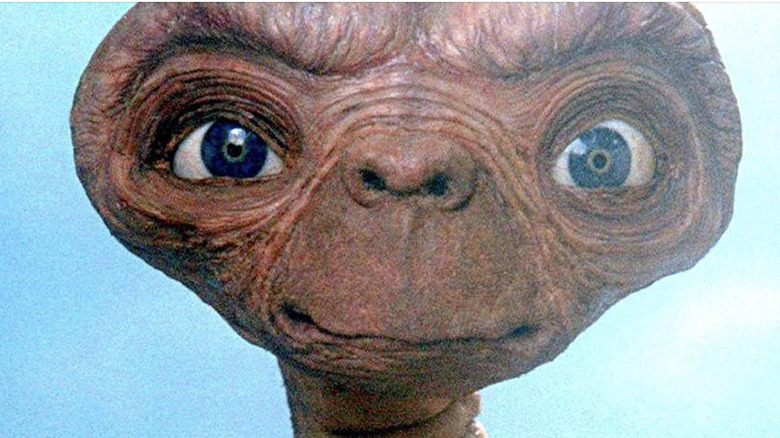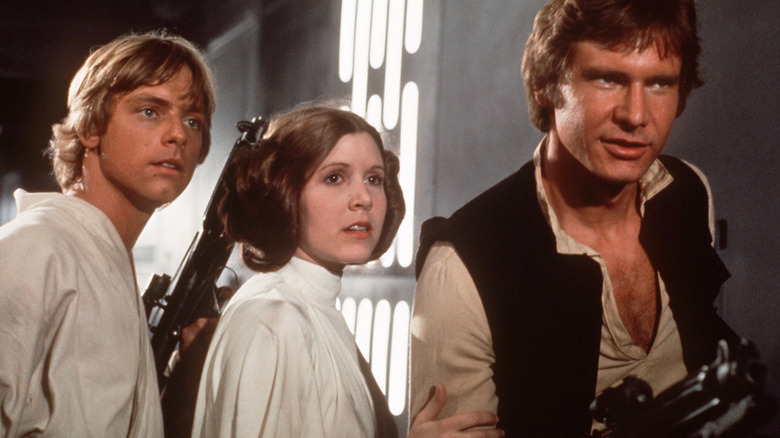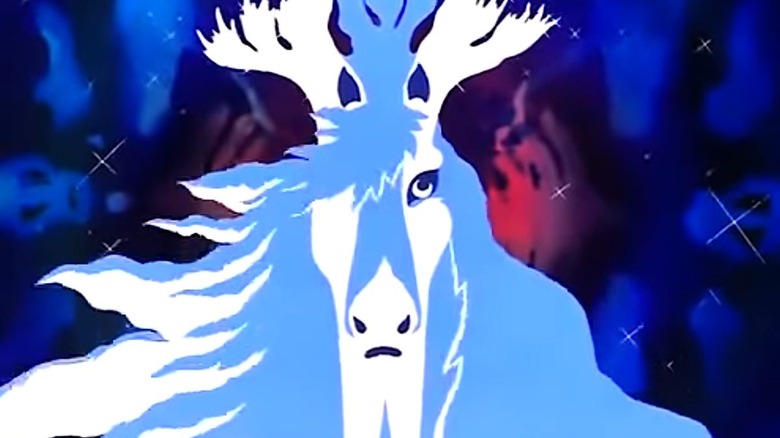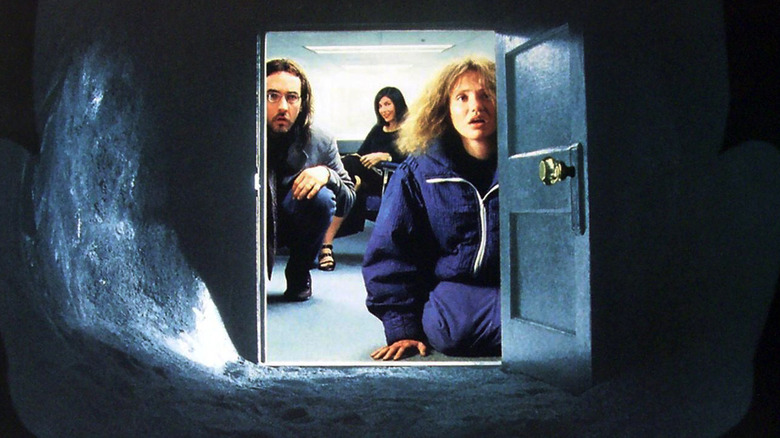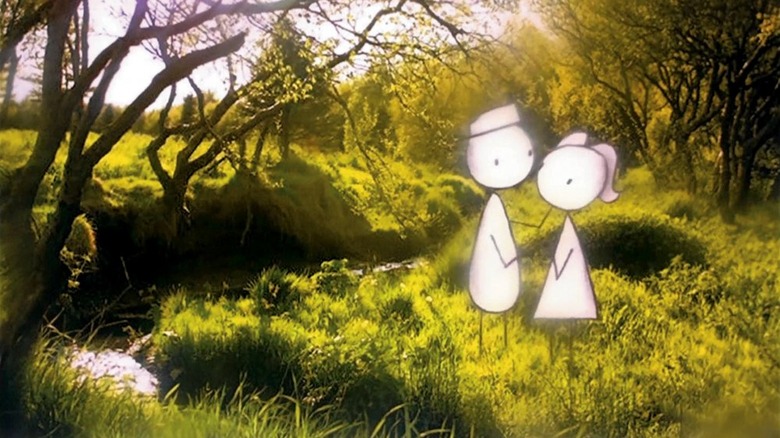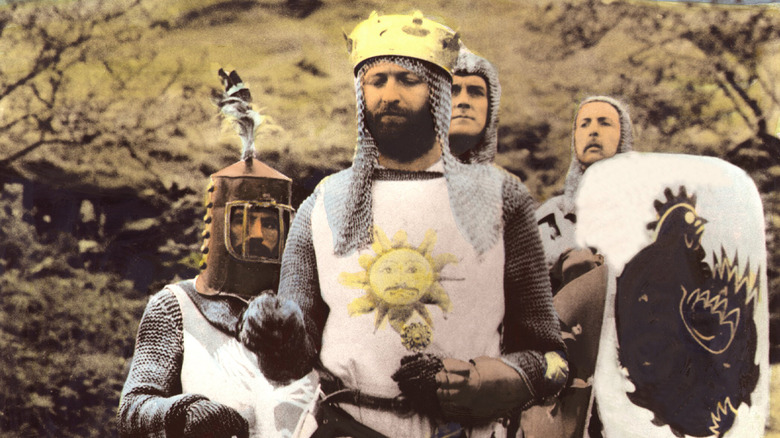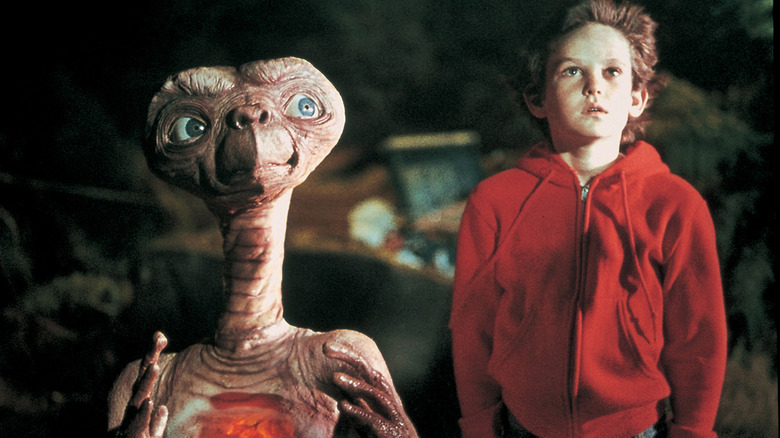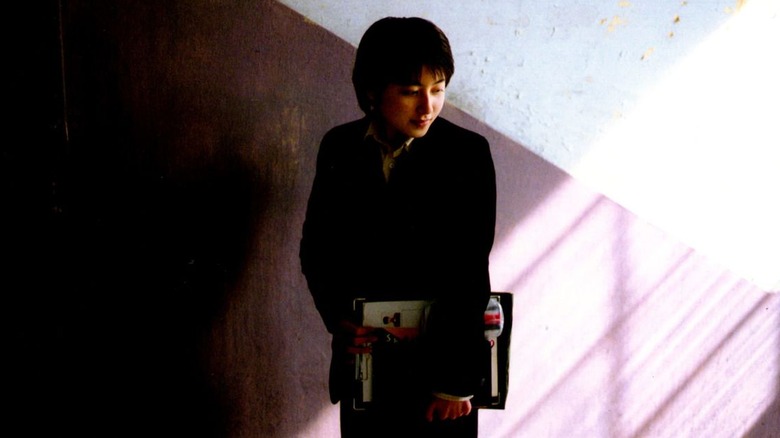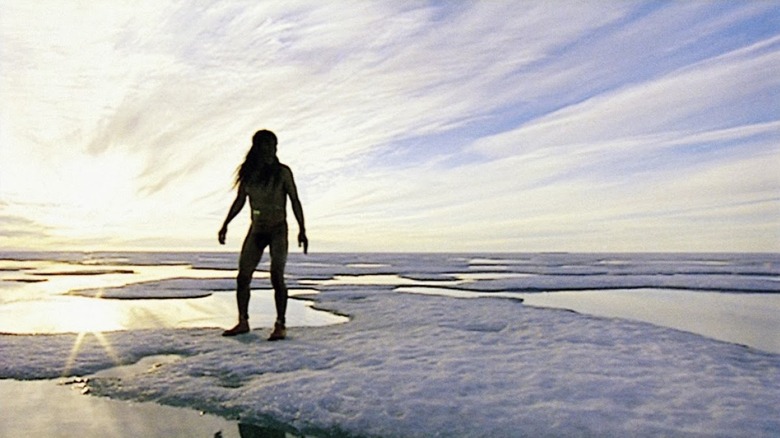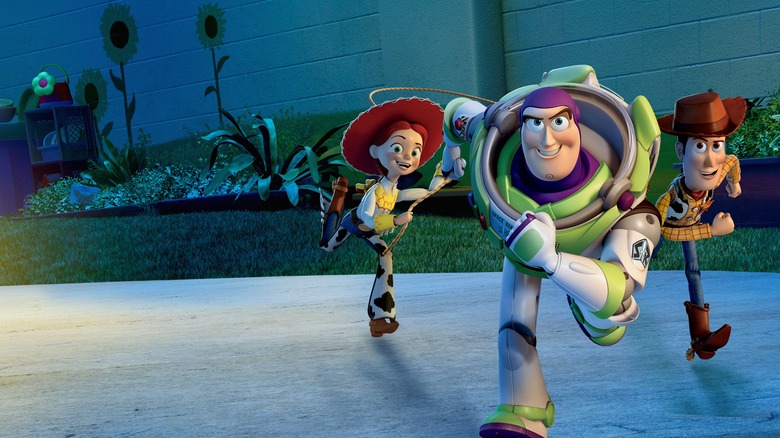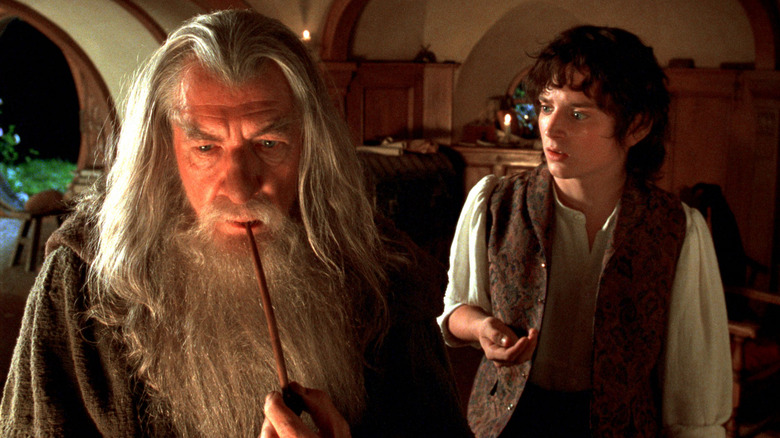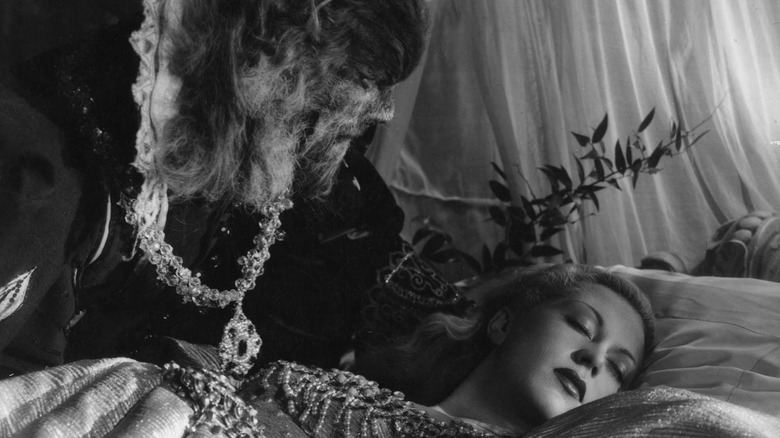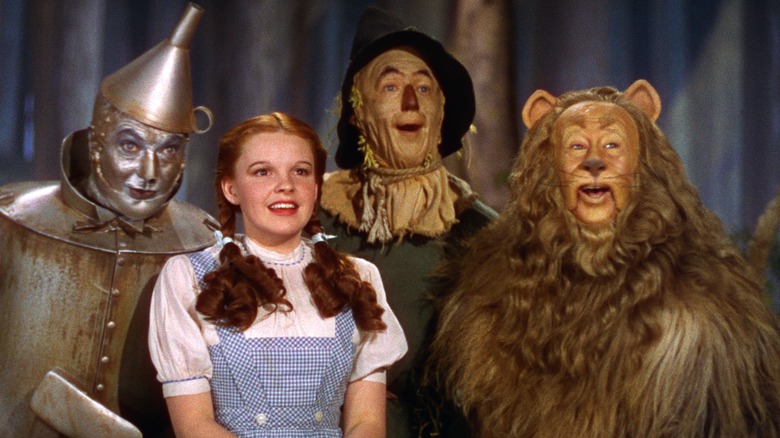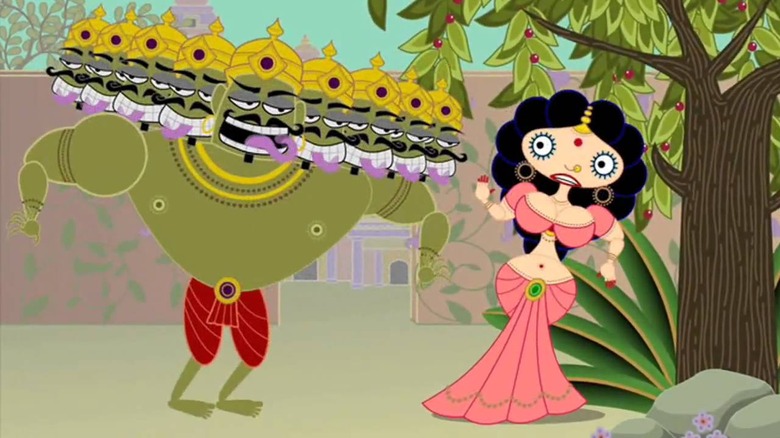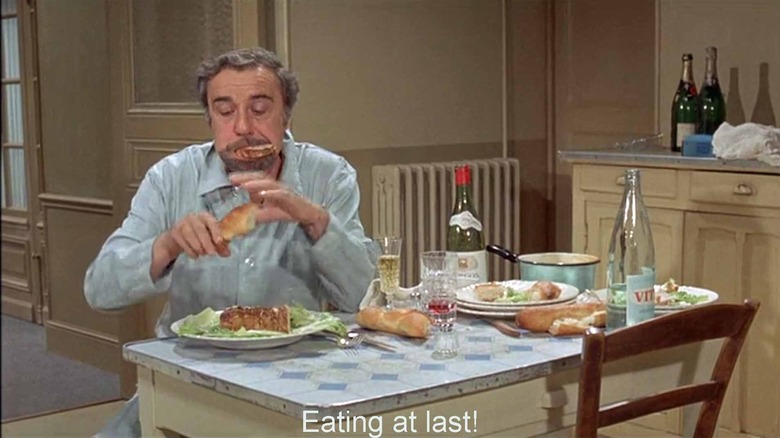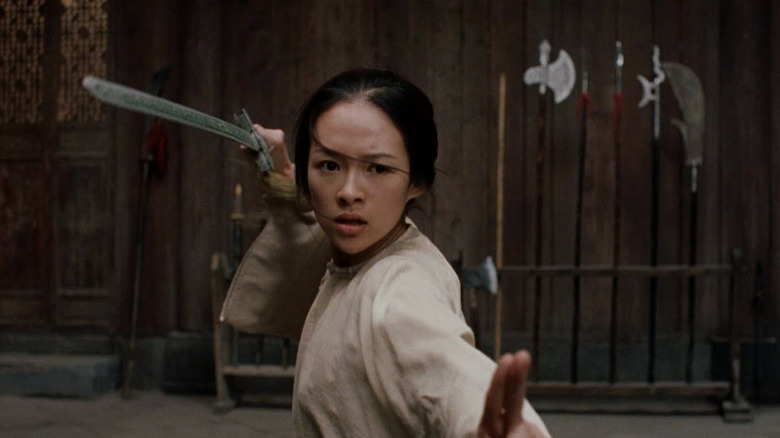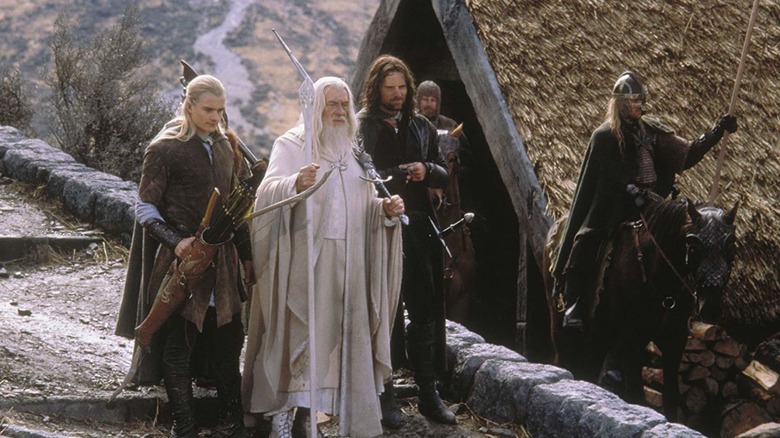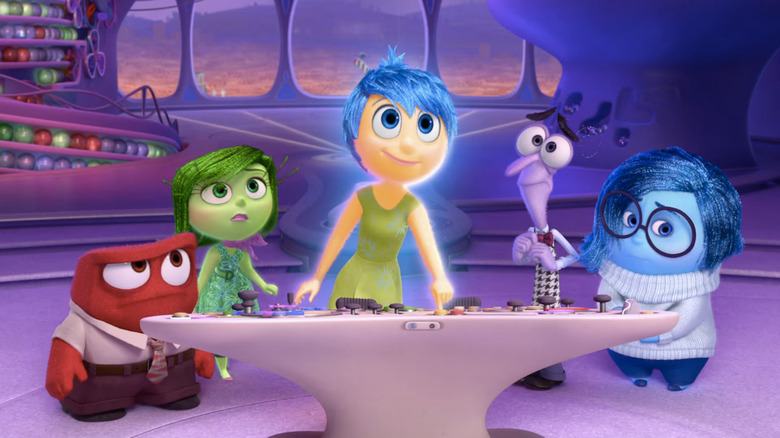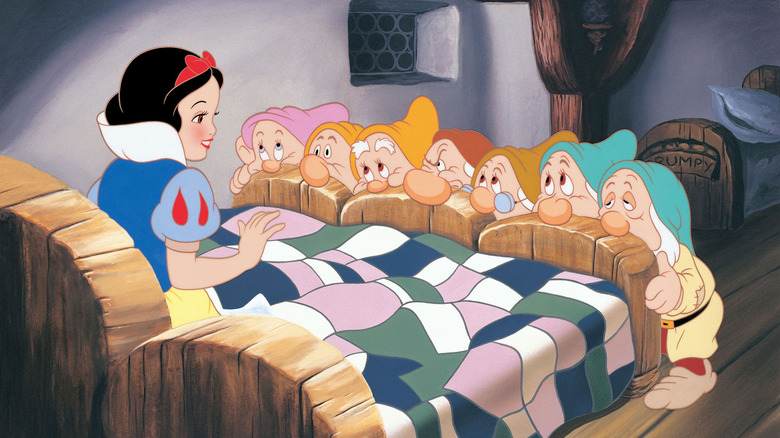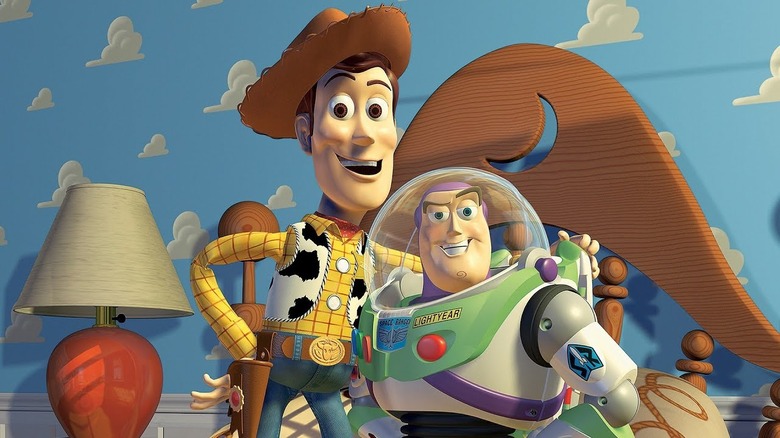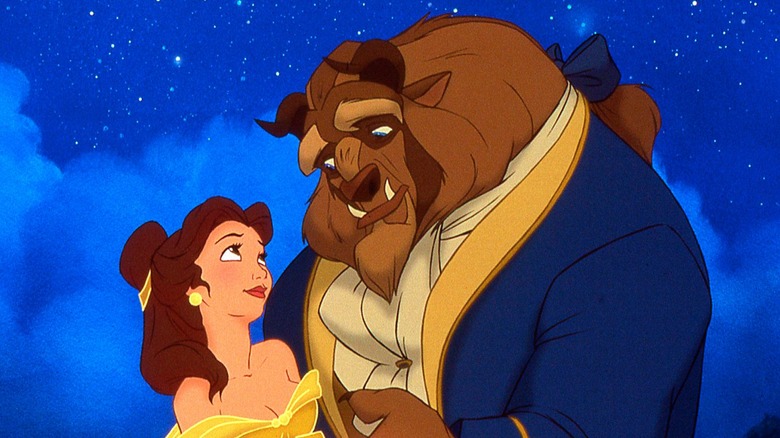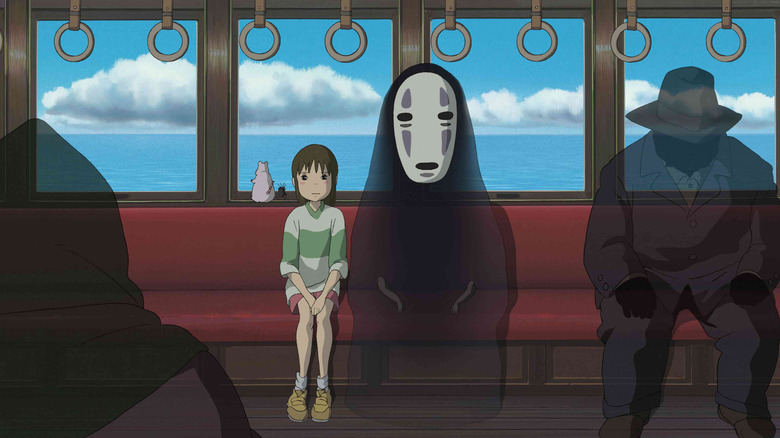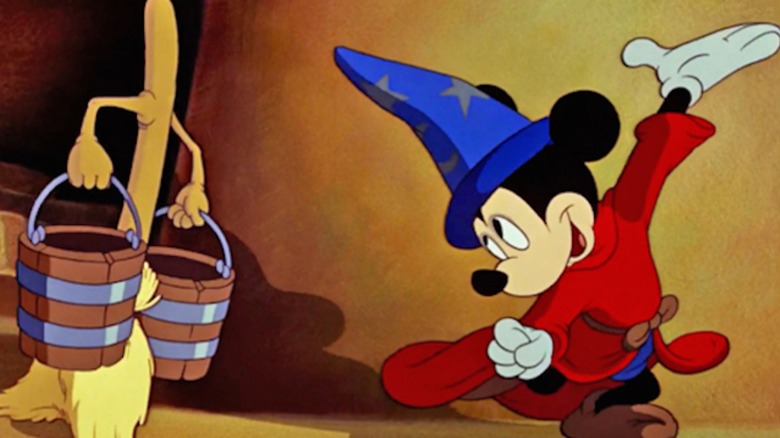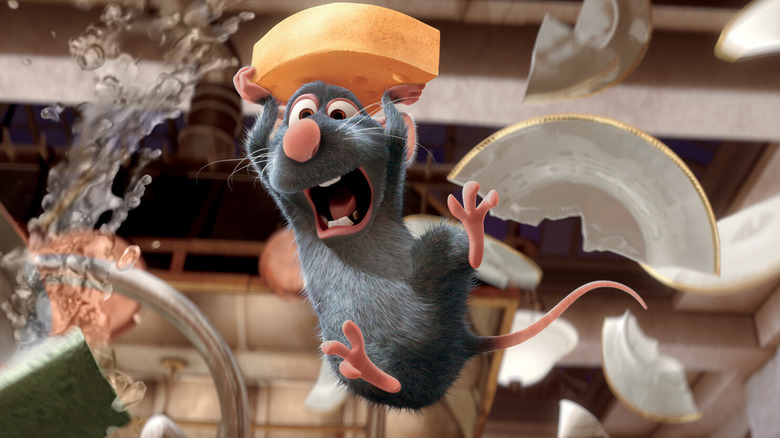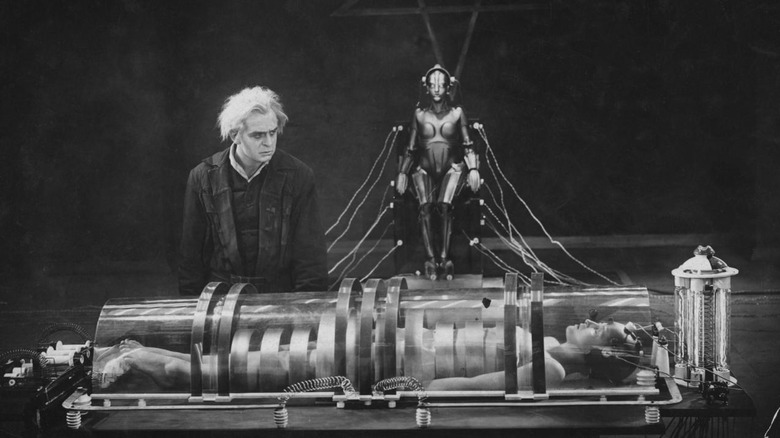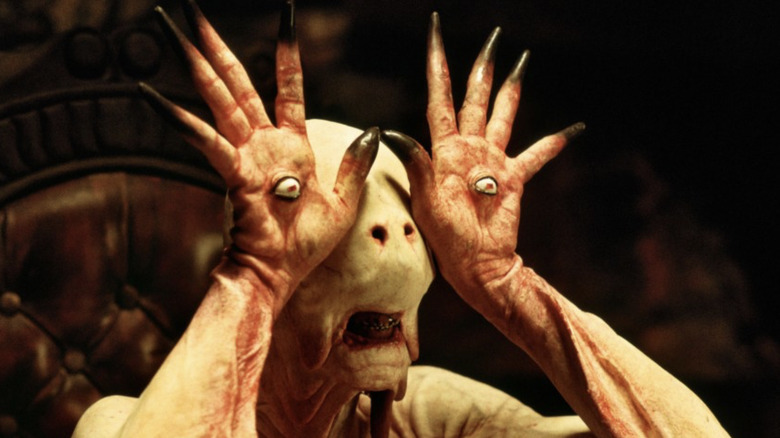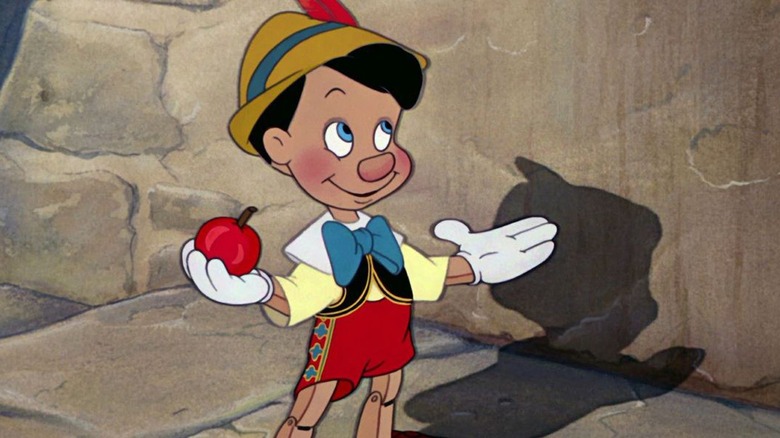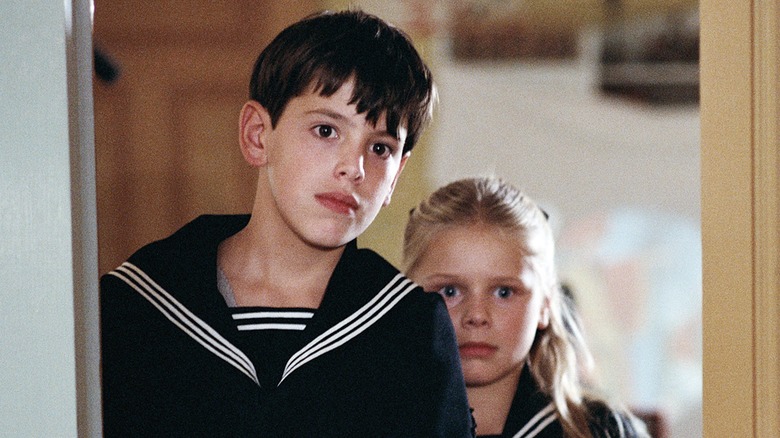There Are 27 Near-Perfect Fantasy Movies According To Metacritic
Partly because it encompasses so much of popular media, we don't consider fantasy a genre in the same way we might think of horror or sci-fi. We didn't typically see "fantasy" sections at the video rental store back in the day. We don't usually see "fantasy" genre tabs on streaming platforms. Ironically, as will be demonstrated shortly, fantasy might be the most significant film genre of all — perhaps even the most influential of any style of fiction.
For the purpose of this list of near-perfect fantasy films — meaning, fantasy films that score 90 percent or higher on the review aggregator Metacritic — let's define fantasy as reality-agnostic fiction that may or may not be influenced by folklore. Fantasy is not merely limited to dragons and wizards and creatures of that nature ... although, as you'll see, it can certainly include a whole bunch of dragons and wizards if the situation calls for them.
Star Wars: Episode IV - A New Hope (1977)
Originally perceived as a quirky pet project from the guy responsible for 1973's "American Graffiti," "Star Wars" — later renamed "Star Wars: Episode IV – A New Hope" — permanently shifted the landscape of popular culture upon its release in 1977. It annihilated box office records; launched a merchandising empire (pun definitely intended); and turned magical characters like Darth Vader and Chewbacca into household names.
But setting all that aside, "A New Hope" plays out as a simple enough story. In fact, practically any teenager who feels stifled by bland, homogeneous suburbia should be able to relate to Luke Skywalker (Mark Hamill). Luke starts this movie — effectively the beginning of the entire Star Wars franchise — as an ambitious young dude stuck on his boring, sandy home planet with a job at his uncle's moisture farm. Luke grows up to be god-master of all space wizards; but as far as "A New Hope" is concerned, he's just an average Jedi trainee with a couple of robot pals and an unfortunate attraction to his sister.
Son of the White Mare (1981)
Originally titled "Fehérlófia," "Son of the White Mare" is a Hungarian animation from 1981 that underwent a 4K restoration and re-release in 2019.
Loosely based in folklore, the film includes baby griffins, knapped princesses, long-lost brothers with superpowers, and unconventional interpretations of dragons. Perhaps the visuals overshadow the plot, but director Marcell Jankovics provides such a bountiful, consciousness-altering technicolor bender for the eyeballs that a relative lightness on story doesn't feel like a major issue.
Despite being decades behind contemporary technology, "Son of the White Mare" actually looks less dated than almost any '90s cartoon that pops to mind, plus plenty of other more recent animated staples. We're not sure how a horse could possibly give birth to a human man who grows up to be a legendary adventurer, but "Son of the White Mare" either offers a satisfactory explanation, or hypnotizes us into not caring. Either way, it does the trick.
Being John Malkovich (1999)
If 1999 was, as some suggest, the greatest single year Hollywood has ever had, and "Being John Malkovich" is 1999's best film, as others have opined, well, hey, maybe this movie is worth a gander if you haven't already had the pleasure.
Director Spike Jonze and screenwriter Charlie Kaufman ground surreal and psychological elements with sadly mundane themes of envy and ingratitude; so even folks who find themselves alienated by art house abstraction may find themselves quite entirely mesmerized and delighted.
John Cusack plays Craig Schwartz — a failed puppeteer, talented file clerk, and more explicitly bitter version of the mediocre schlub archetype that winds up the protagonist of too many movies; Cameron Diaz plays Lotte Schwartz — human companion to several animals and Craig's woefully underappreciated wife; Catherine Keener portrays Craig's acerbic, unrequited office crush; and in a truly astounding coincidence, John Malkovich plays noted screen and theater actor John Malkovich — you know, that guy from the jewel thief movie.
It's Such A Beautiful Day (2012)
Three short films — 2006's "Everything Will Be Okay," 2008's "I'm So Proud of You," and 2011's "It's Such A Beautiful Day" — combine into this hypnotic 2012 feature.
Filmmaker Don Hertzfeldt applies the stick figures and free-association approach to humor of his 2001 career-making revelation, "Rejected," with high- and low-tech animation, plus several experimental twists and turns. The result is a sometimes serene, sometimes terrifying meditation on mental deterioration and death. Bill — the film's simply-drawn protagonist — loses his grip on reality and his own identity over the course of the roughly 60-minute runtime. It gets heavy.
Not unlike David Lynch (in the sense that he's an outsider artist who crossed over to the mainstream more-or-less unaltered), Hertzfeldt's influence resonates throughout "Rick and Morty," "Adventure Time," and oodles of other animation and comedy that bends toward the absurd and/or cosmic. Plus he did one of the all-time greatest couch gags on "The Simpsons."
Monty Python And The Holy Grail (1975)
Would you believe us if we told you one of the all-time great fantasy films also happens to be one of the all-time great comedy films? ... No? ... Why not?
Are you calling us liars?
Seriously though, 1975's "Monty Python And The Holy Grail" is as highly-quotable as any low-budget production guided by sketch performers with no previous feature-length directorial experience has any business being. As a parody whose success surpasses all the earnest King Arthur films that came before or after, "The Holy Grail" inflicted permanent damage to King Arthur's brand name in Hollywood. Thanks to Terry Gilliam and his cohorts, new retellings of the Arthurian legend don't feel like King Arthur movies; they're just overly-serious versions of Monty Python.
But we'll take the Knights Who Say Ni and Flesh Eating Bunnies over some dusty old business about a sword in a lake any day.
E.T. The Extra-Terrestrial (1982)
One of the defining films of its decade and certainly one of director Steven Spielberg's signature achievements, 1982's "E.T. The Extra-Terrestrial" deconstructs the hostile alien invader trope with its shy, cuddly, magic-finger pointing hero. A mishap involving a scientific expedition gone awry saddles the titular long-necked visitor with an unplanned, indefinite vacation on Earth. Luckily, he stumbles upon an instant BFF in 10-year-old Elliott (Henry Thomas), and E.T. sets about returning to his home world with the aid of his new human pals.
"E.T." became such a merchandizing phenomenon that sky-high sales for innumerable tie-in products inflated expectations for an E.T./Atari pairing, setting the stage for a disappointing game that helped crash the entire video game industry. But video games bounced back, and we also have "E.T." to thank for launching a then- 7-year-old Drew Barrymore into a career that would peak, vanish, then resurrect itself into movie super stardom, so everything worked out superbly.
After Life (1998)
Nobody knows what happens after we die, and that big black unknowable provides the groundwork for all kinds of creative works. It's such a common artistic jump-off point that multiple other films either share the title or incorporate the phrase "After Life" somewhere in their name. Forget those other movies though, we're talking about the 1998 Hirokazu Koreeda-directed rumination on memory — and possibly the concept of heaven and hell, if Roger Ebert's interpretation hits the mark.
According to the film's metaphysics, once you die, you can pick one memory to relive for eternity. For most people, that's a complicated choice requiring days of serious consideration. For you, obviously, the answer would be "reading 'Looper,'" so consider yourself lucky. Also noteworthy: despite its supernatural topic, "After Life" includes the fewest special effects of any other film on this list. So, it seems after life resembles regular life more closely than you might expect.
Atanarjuat: The Fast Runner (2001)
One of the many big screen adaptations of folk tales appearing on this list, "Atanarjuat: The Fast Runner" smashed a barrier in 2001 as the first feature-length movie ever produced and performed completely in Inuktitut — one of the handful of languages associated with Inuit people of the global north. It was also shot on location in the northernmost region of Canada, meaning the actors and crew endured considerable temperature-oriented brutality to complete the project. Luckily, "Atanarjuat" was eventually declared the greatest Canadian film of all time, so the efforts were justly rewarded.
Directed by Zacharias Kunuk, "Atanarjuat" chronicles its eponymous main character and his Jerry Springer-esque personal dramas — specifically, his wife's jealous ex-husband murders his brother — that force him to flee for his life, and absolutely validate his nickname. Fair warning: Atanarjuat does his signature fast running in the nude, and the camera does not shy away from his nether region.
Toy Story 3 (2010)
Miraculously, the Toy Story series manages something that Star Wars, The Matrix, Christopher Nolan's Batman saga, and a litany of other "more serious" film franchises failed to pull off — a third movie that was, at one point, generally considered a satisfying conclusion to the previous two films. Obviously, that all changed in 2019 when "Toy Story 4" offered yet another worthy finale to the overarching Toy Story adventure ... but let's not get too sidetracked.
In 2010's addition to the happenings of Buzz, Woody, Mr. Potato Head, and the whole crew, Andy heads off to his freshmen year of undergrad. A related mishap lands his erstwhile talking playthings at the mercy of psychotic toddlers and an evil pink teddy bear voiced by Ned Beatty. If you've heard the ending's a massive tearjerker, we can't confirm or deny that information. We are tough adults who never cry at movies.
The Lord of the Rings: The Fellowship of the Ring (2001)
Back in the late '90s when the Lord of the Rings trilogy entered development, lots of folks assumed Hollywood was making a mistake. Some of us thought J.R.R. Tolkien's quintessential sword and sorcery novels were simply too massive in scope and significance to properly adapt to the big screen. Then director Peter Jackson cranked out a classic and made us all look stupid.
The first and most memorable of the three "Rings" films, "Fellowship" introduces us to Gandalf (Ian McKellen), Frodo Baggins (Elijah Wood) and Aragorn (Viggo Mortensen), along with the rest of the eponymous fellowship as they set about simply walking to Mordor, as one sometimes does ... right?
The performance of Andy Serkis as the twitching, malevolent imp-like Gollum, meanwhile, seemingly ran damage control for the concept of CG characters in live action movies following the debacle of Jar Jar Binks in 1999's "Star Wars: Episode 1 – The Phantom Menace."
Beauty and the Beast (1946)
Whether due to its timelessness, ease of adaptability, or other factors, "Beauty and the Beast" is a French fairy tale originally published in 1756 that appears on this list of near-perfect contemporary fantasy films twice. We're supposing most readers are already familiar with the Disney version from the early '90s, but Jean Cocteau's live action iteration from 1946 may have slipped under your radar. It's not as cute as an animated musical, but it might have equal or more value to those of us with a penchant for gothic overtones and anguished romance.
If Roger Ebert is to be taken at face value, Cocteau coverts pretty much the entire story into a Freudian sexual metaphor. So while it's not an "adult film" in the sense that we typically understand the phrase, this "Beauty and the Beast" isn't really a kids' flick either.
The Wizard of Oz (1939)
When this adaptation of L. Frank Baum's novel was released in 1939, its every detail became permanently tattooed onto the consciousness of pop culture. Although it's hard to find someone who hasn't seen "The Wizard of Oz," it's even harder to find anyone who wouldn't instantly recognize the Cowardly Lion (Bert Lahr), The Tin Man (Jack Haley), The Scarecrow (Ray Bolger), Judy Garland as a resourceful young woman hoping to return to Kansas as soon as possible, and her little dog, too.
The quintet's trip down the Yellow Brick Road forms the backbone of the most influential film of all time, according to what sounds like deeply rigorous research from the Universe of Turin. It's also had a disproportionate influence on our nightmares, via the Wicked Witch of the West (who never actually says "fly my pretties, fly," by the way) and her strike force of winged monkeys.
Sita Sings The Blues (2008)
For all the beats it manages to hit, the 2008 animated gem "Sita Sings the Blues" plays out as a remarkably cohesive piece. Shadow puppets hash out what they remember of the legend of Ramayana between segments of that same legend playing out in a completely different animation style, accompanied by the retro-American pop of Annette Hanshaw. Meanwhile, in a tale running alongside the myth, a character based on writer-director and modern-day Californian Nina Paley takes an unexpected trip to India. So this film is part reinterpreted legend, part memoir, part Annette Hanshaw celebration?
Eh, it's a tough movie to explain. Maybe you should just watch it right here for free and legally instead. Paley registered "Sita Sings the Blues" as a legally public domain work as of 2010, and if you've got two hours to kill, it's hard to imagine a better under-the-radar film to discover.
The Discreet Charm of the Bourgeoisie (1972)
American society has quite a bit — arguably, too much — reverence for its wealthiest citizens. Look no further than the Kardashians, Donald Trump and Elon Musk. Regardless of what your personal opinion about these people may be, inarguably, none of them would've ended up where they got if being rich wasn't considered a signifier of overall value.
French director Luis Buñuel did not happen to share this American disposition regarding the wealthy, as indicated via his 1972 surrealistic comedy "The Discreet Charm of the Bourgeoisie." The New York Times put together a pretty thorough explainer of the film; it's a movie about all the things that can go wrong during a fancy dinner with glamorous, exciting guests — if said dinner suddenly finds itself at the mercy of your subconscious mind's fluid reality.
Crouching Tiger, Hidden Dragon (2000)
In what's also one of the greatest martial arts movies of all time, director Ang Lee spins a timeless tale about teen romance, a stolen sword, systemic misogyny, and legendary warriors who might be absolute badasses, but need to get in touch with their feelings if they hope to experience true happiness.
The success of "Crouching Tiger" — the most successful Chinese language film in history, as far as American box office is concerned — inspired an influx of Chinese releases with similar elements including 2002's "Hero" and 2004's "The House of Flying Daggers." Additionally, and entirely by accident, Le Mu Bai (Chow Yun-Fat), Yu Shu Lien (Michelle Yeoh), Jen the reluctant bride (Ziyi Zhang), and the malicious Jade Fox (Pei-Pei Cheng) all fight with a total ambivalence for the laws of physics, continuing a trend that began with "The Matrix" the year prior.
The Lord of the Rings: The Return of the King (2003)
As we've been reminded of late, coming up with an ending to a high-fantasy epic that satisfies everyone can be extremely difficult. So Peter Jackson and company were roundly praised when "The Return of the King" stuck the landing for the "Rings" trilogy in 2003 — and they have the Best Picture Oscar to prove it.
Building to a resolution, the primary elements of the trilogy come to a boil: fierce medieval battles, Frodo's existential crisis, Smeagol's obsession with the "precious" and, of course, all the drama surrounding that wacky ring.
To call the 2003 blockbuster an "epic" doesn't quite do it justice. There needs to be a phrase that means more epic than epic. Maybe it should be "return the king," as in, "That radical skateboard trick you just did totally returns the king, dude."
Inside Out (2015)
With 2015's "Inside Out," Disney and Pixar asked the question: "What if each of your emotions were characters voiced by celebrity comedians? Would it make for a thoroughly charming, funny, unusually-clever viewing experience for anyone who happened to be watching from a third-person perspective?" The answer, as it turns out, is yes.
Amy Poehler and Phyllis Smith voice the personifications of Joy and Sadness living in the brain of a 10-year-old girl. The two polarities must correct a disastrous imbalance in their charge's memory and personality containment sections when her family moves to a new city, and the adjustment goes a little rougher than anticipated. It's a little like "Anatomy Park" from "Rick & Morty," except not as literal or disgusting.
Stay tuned until the credits to find out what happens inside the minds of dogs and cats. (Spoiler: It's probably what you expect, but it's nevertheless visually actualized to a profound degree of hilariousness.)
Snow White and the Seven Dwarfs (1937)
There aren't too many films that match or surpass the culture-transforming level of "A New Hope" and "Wizard of Oz," but one of them might be "Snow White and The Seven Dwarfs." Released in 1938, the first feature-length Disney movie set the template for hundreds of animated children's films released during the subsequent decades, continuing to this day. It's also the first of a handful of Brothers Grimm fairy tales Disney mined for source material.
While the contributions of the charming princess and her male companion get the star status, the supporting cast in "Snow White" easily steals the show. Primary antagonist and evil Queen Maleficent went on to headline a live action Angelina Jolie franchise, while the shorter-than-average folks named after emotions and conditions are so beloved that they must wander the Magic Kingdom shaking hands and dancing for tourists forevermore.
Toy Story (1995)
Not totally unlike "Snow White and the Seven Dwarfs," Pixar's 1995's franchise-starter "Toy Story" permanently shifted the landscape of children's films — or perhaps, the entire landscape of blockbuster cinema — by legitimizing computer animation as capable of producing just as much wonder and charm as the traditional, hand-drawn stuff. It's also a deft squishing together of multiple genre troupes — buddy movie, road movie, fish-out-of-water — and the introduction of Tom Hanks as Woody the cowboy and Tim Allen as Buzz Lightyear the cosmic adventurer.
Even if the fundamental concept about toys that come to life when people aren't looking is borrowed from 1986's "The Christmas Toy," that lesser-known endeavor from The Jim Henson Company can't match the spectacular quipping of "Toy Story" — the first major league gig for a then c-list Hollywood screenwriter named Joss Whedon (who wrote the script with seven other people). Not only would children's animation be very different today if "Toy Story" hadn't been a home run — "The Avengers" and "Justice League" both might've had a different director.
Beauty and The Beast (1991)
It's fiction's most romantic children's story about Stockholm syndrome, a celebration of literacy, and a case against the wisdom of the torch-wielding mob. In a more grounded sense, 1991's "Beauty and the Beast" arguably marks the crowning achievement of the Disney renaissance period that occurred from the late '80s to the late '90s.
As a young woman and book fanatic stuck in a mid-18th century French village, Belle is bored out of her mind until her dad finds himself the prisoner of a castle-dwelling monster. Belle agrees to swap places with her old man as the Beast's hostage, and before she knows it, she's caught up in the middle of a magic curse, a severely unexpected romance, and the ambitions of a big game hunter turned small-town demagogue named Gaston. "Beauty and the Beast" was a Best Picture nominee at the 1992 Oscars, and in the eyes of many should have taken the statue home.
Spirited Away (2001)
If this is to be a definitive list of unassailable fantasy cinematic sagas, Studio Ghibli is notably underrepresented. Most notable, perhaps, is the absence of 1997's brilliant "Princess Mononoke." But at least one of director Hayao Miyazaki's essential, staggering animations found its way into Metacritic's extra-good graces.
At the onset of 2001's "Spirited Away," a young girl named Chihiro travels with her parents; the family stops at an abandoned amusement park, and mom and dad swiftly transform into pigs. Searching for a way to reverse her progenitors' magical condition, Chihiro heads to a spirit realm, where she finds new employment and a whole new identity at a bathhouse that is frequented by various elements of Japanese folklore (and might not really exist).
The film's most iconic moments unfold during a quiet and particularly striking scene on a train where, technically, nothing happens. It's simple, beautiful and unforgettable.
Fantasia (1940)
A major innovation both for its blending of classical music with contemporary animation and its deployment of surround sound to transfer the package into a movie theater, "Fantasia" demonstrated the further broadening of Disney's ambitions in 1940. Rather than a single narrative plot, the first "Fantasia" contains eight short films with ambiance and energy provided by the Philadelphia Orchestra. It's probably not literally the first music video, but as far as combinations of previously unconnected visual and auditory media are concerned, it could be.
Because it features one of the most recognizable fictional character/logos in corporate history, "The Sorcerer's Apprentice" is the first segment of Fantasia everyone thinks of. But truth be told, compared to far superior sections like "Rite of Spring" (which depicts the last days of the dinosaurs) or the marvelous ballet-dancing zoo animals of "Dance of the Hours," "The Sorcerer's Apprentice" is probably the third-best short in the collection.
Ratatouille (2007)
Rats get a bad rap. Of course, they deserve at least some of the blame for the Black Plague — the worst pandemic in global history — but that happened more than 700 years ago, so maybe it's time to show them some love.
"Ratatouille" went a long way towards rehabilitating the public image of rats, giving the creatures a heroic spin courtesy of Disney and Pixar. Patton Oswalt voices Remy — a Paris-residing gentlemen of the rat species who simply desires to eat substances designed specifically for consumption, rather than whatever he manages to scrounge up from the garbage. His quest for high-end people-food leads to a mishap that lands him a gig at a gourmet restaurant, but he must toil in secret due to the aforementioned anti-rodent discrimination.
Years later, the film still has a deeply-loyal fanbase. A TikTok musical made headlines during the COVID-19 pandemic (ironic, because during this pandemic, people wanted to see a rat), and although talk of a sequel is speculative at best, for years it seemed like there'd never be another "Finding Nemo" either.
Metropolis (1927)
Fritz Lang's touchstone "Metropolis" wasn't the first sci-fi movie, but it did play a part in establishing concept and character archetypes — mad scientists, sentient robots, class struggles — that carry on as staples of the genre. In fact, the film's flying cars and sleek architecture make you wonder if this is what the "Blade Runner" version of Los Angeles would look like if the sun came out every now and then.
The nuances of early 20th century German expressionism and the silent film era add up to a piece of historic media, inviting interpretations of all stripes. But considering the way Lang doles out breathtaking image after breathtaking image, you may find yourself not caring that you have no idea what's going on.
"Metropolis" was considered a monumentally ambitious project in its day — even taking that into consideration, it's amazing how well its power of spectacle holds up after nearly 100 years of technological advancements.
Pan's Labyrinth (2006)
When audiences think about darkness and whimsy meshed together into elaborate cinematic adventures, they tend to think of Tim Burton — director of 1990's "Edward Scissorhands," 1999's "Sleepy Hollow" 1994's "Ed Wood," and several others. But with 2006's "Pan's Labyrinth," director Guillermo del Toro proved that he could do Burton's supernatural gloom and fairy tale wonder just as well as Tim Burton — maybe even better.
Set during the 1940s in Francisco Franco's authoritarian Spain, this Spanish-language modern classic documents the tale of Ofelia — a young girl whose mother plans to marry fascist scumbag Captain Vidal. While staying at Vidal's compound, Ofelia discovers the titular labyrinth, meets Pan, and eventually comes across a humanoid monstrosity who eats faeries and keeps his eyeballs in the palms of his hands. Sound freaky? You bet it is.
Pinocchio (1940)
Plenty of folks in the late 1930s thought Disney couldn't possibly follow up "Snow White" with a project of equal or greater merit. But The Mouse proved all those second-guessers wrong with 1940's "Pinocchio."
Borrowing source material from Carlo Collodi's 1883 novel, "The Adventures of Pinocchio," Disney's "Pinocchio" actually raised the bar again for animation quality. It also metaphorically conveyed the perils of lying, placing short-term fame and glory ahead of a well-rounded education, smoking, drinking, and allowing oneself to be eaten by a whale.
Metacritic gives this one a 99 — if taken literally, that places it ahead of "Snow White," "Beauty and the Beast," "Toy Story" and all the other existing Disney movies. So either critics have been harsher on Disney's subsequent films, or The Mouse never topped this iconic sophomore effort.
Fanny and Alexander (1982)
As stated at the onset, "fantasy" works out to be an extremely broad term.
Case in point: This list began with "A New Hope" as the 27th-greatest fantasy film, and according to Metacritic's ranking system, the number one fantasy film ever made is "Fanny and Alexander," a Swedish-language Ingmar Bergman movie the filmmaker originally intended to be his final, career capstone project.
But perhaps Bergman and George Lucas aren't as far apart as some might assume, and "Fanny and Alexander" should have spawned a hugely-successful line of action figures.
Released in 1982, "Fanny" is either three or five-and-a-half hours long, depending on which edit you happen to watch. Bergman's autobiographical epic touches upon the joys, horrors, and unique perspectives of childhood, while echoing any number of other stories involving wicked stepparents.
Is it the most perfect fantasy film ever made? Better than "A New Hope," "ET" and "The Wizard of Oz"? Give the film a try, and you be the judge.
